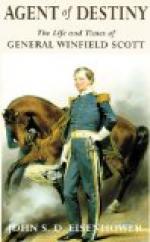The northwestern army at this time consisted of about ten thousand troops. General Henry Dearborn held command near Plattsburg and Greenbush, and was the commanding officer of all the forces on the northern frontier. A portion of his army was camped at Lewistown under the command of General Stephen Van Rensselaer, of New York. General Alexander Smyth was at Buffalo with some fifteen hundred regular troops. Besides these, there were small detachments at Ogdensburg, Sackett’s Harbor, and Black Rock.
General Van Rensselaer conceived the plan of making a bold and sudden move into Canada, with a view of capturing Jamestown, and there establishing winter quarters. The affair of the capture of the two English brigs with fifty men had roused great enthusiasm, and the country was anxious for some success of arms to alleviate the depression occasioned by Hull’s surrender. General Van Rensselaer confided the immediate command of the expedition to his relative, Colonel Solomon Van Rensselaer, an officer of coolness and courage, who, with three hundred militia and three hundred regulars, under Colonel Chrystie, on October 13th began crossing the river.
The troops were on the river bank ready to embark an hour before daylight, but from some mismanagement there was not a sufficient number of boats to transport the whole, and they were compelled to cross in detachments. Colonel Chrystie’s boat was swept down the river by the current, and he was wounded. On a second attempt he succeeded in landing. With about a hundred men Colonel Van Rensselaer led them up the bank, and halted to await the arrival of the remainder. It was now daylight, and the little command was in full view of the enemy, who opened a deadly fire. Every commissioned officer was either killed or wounded. Finding that the river bank afforded but little protection, Colonel Van Rensselaer determined to storm the Queenstown heights. He had now received four wounds, and was compelled to relinquish the command to Captains Peter Ogilvie, Jr., and John Ellis Wool. In a very short time the fort was taken and the heights occupied by the Americans. The enemy took refuge in a stone house, from which they opened a destructive fire and made two unsuccessful attempts to recapture the lost ground. General Brock rallied his men and led them on, but while moving at the head of the Forty-ninth Grenadiers he fell mortally wounded. General Van Rensselaer recrossed the river and assumed command, but hastening back to urge forward re-enforcements, the command fell to General Decius Wadsworth, who, however, did not assume to control the movements. Two light batteries from the Canada shore played on the boats attempting to cross, and there was no artillery with which the Americans could resist.
Colonel Scott had volunteered his services for the expedition, but they were declined, for the reason that arrangements had been made for detachments under Colonel John R. Fenwick and Lieutenant-Colonel James Robert Mullaney to sustain the assaulting columns. Permission was, however, given to Colonel Scott to march his regiment to Lewiston and act as circumstances might require.




